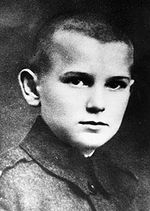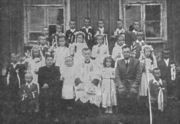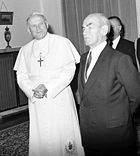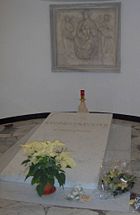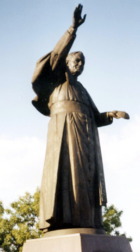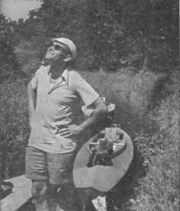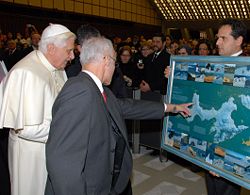Pope John Paul II
2008/9 Schools Wikipedia Selection. Related subjects: Religious figures and leaders
| John Paul II | |
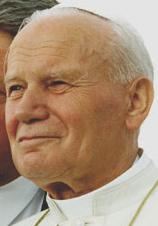 |
|
| Papacy began | 16 October 1978 |
|---|---|
| Papacy ended | 2 April 2005 |
| Predecessor | John Paul I |
| Successor | Benedict XVI |
| Birth name | Karol Józef Wojtyła |
| Born | 18 May 1920 Wadowice, Poland |
| Died | 2 April 2005 (aged 84) Apostolic Palace, Vatican City |
| Styles of Pope John Paul II |
|
 |
|
| Reference style | His Holiness |
| Spoken style | Your Holiness |
| Religious style | Holy Father |
| Posthumous style | Servant of God |
John Paul II (Latin: Ioannes Paulus PP. II, Italian: Giovanni Paolo II, Polish: Jan Paweł II) born Karol Józef Wojtyła IPA: [ˈkaɾɔl ˈjuzεf vɔi̯ˈtɨwa]; 18 May 1920 – 2 April 2005) reigned as the 263rd Pope of the Roman Catholic Church and Sovereign of the State of the Vatican City from 16 October 1978 until his death, almost 27 years later. His was the second-longest pontificate after Pius IX's 32-year reign. He has been the only Polish pope, and was the first non- Italian pope since the Dutch Adrian VI in the 1520s.
John Paul II was Pope during a period in which the Catholic Church's influence declined in developed countries but expanded in the Third World. During his reign, the pope traveled extensively, visiting over 100 countries, more than any of his predecessors. He remains one of the most-traveled world leaders in history. He was fluent in numerous languages: his native Polish and also Italian, French, German, English, Spanish, Croatian, Portuguese, Russian and Latin. As part of his special emphasis on the universal call to holiness, he canonized a great number of people.
He beatified 1,340 people (some listed here), more people than any previous pope. The Vatican asserts he canonized more people than the combined tally of his predecessors during the last five centuries, and from a far greater variety of cultures. Whether he had canonized more saints than all previous popes put together, as is sometimes also claimed, is difficult to prove, as the records of many early canonizations are incomplete, missing, or inaccurate. However, it is known that his abolition of the office of Promotor Fidei ("Promoter of the Faith") streamlined the process.
Biography
Early life
Karol Józef Wojtyła was born on 18 May 1920 in the Polish town of Wadowice and was the youngest of three children of Karol Wojtyła and Emilia Kaczorowska. His mother died on April 13, 1929, when he was just nine years old, and his father supported him so that he could study. His brother, who worked as a doctor, died when Wojtyła was twelve. He lost everyone in his family - a sister, brother, mother, and father - before he became a priest. His youth was marked by extensive contacts with the then thriving Jewish community of Wadowice. He played sports during his youth, and was particularly interested in football (soccer) as a goalkeeper.
After completing his studies at the Marcin Wadowita high school in Wadowice, in 1938 Wojtyła enrolled at the Jagiellonian University in Kraków, and in a school for drama. He worked as a volunteer librarian and did compulsory military training in the Academic Legion, but refused to hold or fire a weapon. In his youth he was an athlete, actor and playwright and he learned as many as ten languages during his lifetime, including Latin, Ukrainian, Croatian, Greek, Dutch, Spanish, Portuguese, French, Italian, German, English as well as his native Polish. He also had some facility with Russian.
In 1939, Nazi occupation forces closed the Jagiellonian University. All able-bodied males had to have a job. From 1940 to 1944 Wojtyła variously worked as a messenger for a restaurant and a manual labourer in a limestone quarry, and then as a salesman for the Solvay chemical factory to avoid being deported to Germany. His father died of a heart attack in 1941. B'nai B'rith and other authorities have said he helped Jews find refuge from the Nazis.
On 29 February 1944, Wojtyła was knocked down by a German truck. In sharp contrast to the harshness normally expected from the occupiers, German officers tended him and commandeered a passing truck to get him to a hospital. He spent two weeks there with a severe concussion and a shoulder injury. This accident and his survival seemed to Wojtyła a confirmation of his priestly vocation. On 6 August 1944, "Black Sunday", just after the Warsaw uprising began, the Gestapo rounded up young men in Kraków to avoid a similar uprising. Wojtyła escaped by hiding in the basement of his home as it was searched, then escaped to the Archbishop's residence, where he stayed until after the war.
On the night of 17 January 1945, the Germans quit the city, and the seminarians reclaimed the ruined seminary. Wojtyła and another seminarian volunteered for the odious task of chopping up and carting away piles of frozen excrement from the lavatories. That month, Wojtyła personally helped a 14-year-old Jewish refugee girl named Edith Zierer who had run away from a Nazi labor camp in Częstochowa. Zierer was attempting to reach her family in Kraków but had collapsed from cold and exhaustion on a train platform in Jędrzejów. No one helped but Wojtyła, who gave her some hot tea and food, personally carried her to a train and accompanied her to Kraków. Zierer credits Wojtyła for saving her life that day. She would not hear of her benefactor again until she read that he was elected as the Pope in 1978.
Priest
In 1942 he entered the underground seminary run by the Archbishop of Kraków, Cardinal Adam Stefan Sapieha. Karol Wojtyła was ordained a priest on 1 November 1946, by Cardinal Sapieha. Not long after, he was sent to study theology at the Pontifical Athenaeum of St. Thomas Aquinas in Rome, Italy, commonly known as the Angelicum, where he earned a licentiate and later a doctorate in sacred theology. This doctorate, the first of two, was based on the Latin dissertation Doctrina de fide apud S. Ioannem a Cruce (The Doctrine of Faith According to Saint John of the Cross). Even though his doctoral work was unanimously approved in June 1948, he was denied the degree because he could not afford to print the text of his dissertation (an Angelicum rule). In December of that year, a revised text of his dissertation was approved by the theological faculty of Jagiellonian University in Kraków, and Wojtyła was finally awarded the degree.
Returning to Poland in the summer of 1948, with his first pastoral assignment in the village of Niegowić, fifteen miles from Kraków. In March 1949, he was transferred to Saint Florian's parish in Kraków. He taught ethics at the Jagiellonian University in there and subsequently at the Catholic University of Lublin. Wojtyła gathered a group of fewer than 20 young people, who began to call themselves Rodzinka, the "little family", who met for prayer, philosophical discussion, and helping the blind and sick. Eventually there were some 200 people in his circle, which came to be called Środowisko, meaning roughly "milieu". The group went on both skiing and kayaking trips annually.
Fr Wojtyła wrote a series of articles in Kraków's Catholic newspaper Tygodnik Powszechny ("Universal Weekly") dealing with contemporary church issues, and his literary work blossomed in his first dozen years as a priest. The war, life under communism, and his pastoral responsibilities all fed his poems and plays. These were published under two pseudonyms-Andrzej Jawień, and Stanisław Andrzej Gruda. He used these pseudonyms firstly to distinguish his literary from his religious writings, which were published under his own name, and also so that his literary work would be considered on their own merits rather than as clerical curiosities.
He earned a second doctorate, based on an evaluation of the possibility of founding a Catholic ethic on the ethical system of phenomenologist Max Scheler (An Evaluation of the Possibility of Constructing a Christian Ethics on the Basis of the System of Max Scheler), in 1954. As was the case with the first degree, he was not granted the degree upon earning it. This time, the faculty at Jagiellonian University was forbidden by communist authorities from granting the degree. In conjunction with his habilitation at Catholic University of Lublin, Poland, he finally obtained the doctorate of philosophy in 1957 from that institution, where he had assumed the Chair of Ethics in 1956.
Bishop and cardinal
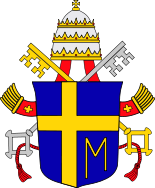
On 4 July 1958 Pope Pius XII named him titular bishop of Ombi and auxiliary to Archbishop Baziak, apostolic administrator of the Archdiocese of Kraków. He was consecrated to the Episcopate by Arcbishop Baziak on September 28, 1958. At 38 Karol Wojtyła was the youngest bishop in Poland. Pope John Paul II recounts in his book Rise, Let us be on our Way how he entered a room a full of priests, after news had been received of his appointment as auxiliary Bishop, when Archbishop Baziak called out "Habemus papam" ("We have a Pope"). Baziak died in June 1962 and on July 16 Karol Wojtyła was elected as Vicar Capitular, or temporary administrator, of the Archdiocese until an Archbishop could be appointed.
Starting in October 1962 Bishop Wojtyła took part in the Second Vatican Council, and in December 1963 Pope Paul VI appointed him Archbishop of Kraków. On 26 June 1967, Paul VI announced Archbishop Wojtyła's promotion to the Sacred College of Cardinals with the title of Cardinal Priest of San Cesareo in Palatio.
He made contributions to two of the most historic and influential products of the council, the Decree on Religious Freedom (in Latin, Dignitatis Humanae) and the Pastoral Constitution on the Church in the Modern World ( Gaudium et Spes).
In 1960, Wojtyła had published the influential book Love and Responsibility, a defense of the traditional Church teachings on sex and marriage from a new philosophical standpoint. In 1967, he was instrumental in formulating the encyclical Humanae Vitae which deals with those same issues and forbids abortion and artificial birth control.
A Pope from Poland
In August 1978 following Paul's death, he voted in the Papal conclave that elected Pope John Paul I, who at 65 was considered young by papal standards. However, John Paul I died after only 33 days as pope, thereby precipitating another conclave.
Voting in the second conclave was divided between two particularly strong candidates: Giuseppe Siri, the Archbishop of Genoa; and Giovanni Benelli, the Archbishop of Florence and a close associate of Pope John Paul I. In early ballots, Benelli came within nine votes of victory. However, Wojtyła secured election as a compromise candidate, in part through the support of Franz Cardinal König and others who had previously supported Cardinal Siri.
He became the 264th Pope according to the chronological List of popes. At only 58 years of age, he was the youngest pope elected since Pope Pius IX in 1846. Like his immediate predecessor, Pope John Paul II dispensed with the traditional Papal coronation and instead received ecclesiastical investiture with the simplified Papal inauguration on 22 October 1978. During his inauguration, when the cardinals were to kneel before him to take their vows and kiss his ring, he stood up as the Polish prelate Stefan Cardinal Wyszynski knelt down, stopped him from kissing the ring and hugged him (SABC2 "The Greatest souls" documentary 2005). As Bishop of Rome he took possession of his Cathedral Church, the Basilica of St. John Lateran, on 12 November 1978.
Assassination attempts
On 13 May 1981 John Paul II was shot and critically wounded by Mehmet Ali Ağca, a Turkish gunman, as he entered St. Peter's Square to address an audience. He was rushed into the Vatican complex, then to the Gemelli Hospital, where Dr. Francesco Crucitti, a noted surgeon, had just arrived by police escort after hearing of the incident. The Pope had lost almost three-quarters of his blood, a near- exsanguination, despite the fact that the bullets missed his mesenteric artery and abdominal aorta. He underwent five hours of surgery to treat his massive blood loss and abdominal wounds. En route to the hospital, he lost consciousness. Ağca was caught and restrained by a nun and other bystanders until police arrived. He was sentenced to life imprisonment. Two days after Christmas 1983, John Paul II visited the prison where his would-be assassin was being held. The two spoke privately for 20 minutes. John Paul II said, "What we talked about will have to remain a secret between him and me. I spoke to him as a brother whom I have pardoned and who has my complete trust." The pope also stated that Our Lady of Fatima helped keep him alive throughout his ordeal.
| “ | Could I forget that the event [Ali Ağca's assassination attempt] in St. Peter’s Square took place on the day and at the hour when the first appearance of the Mother of Christ to the poor little peasants has been remembered for over sixty years at Fátima, Portugal? For in everything that happened to me on that very day, I felt that extraordinary motherly protection and care, which turned out to be stronger than the deadly bullet. | ” |
|
—Pope John Paul II -Memory & Identity, Weidenfeld & Nicolson, 2005, p.184 |
||
On 2 March 2006, an Italian parliamentary commission concluded that the Soviet Union was behind the attempt, in retaliation for John Paul II's support of Solidarity, the Catholic, pro-democratic Polish workers' movement, a theory which had already been supported by Michael Ledeen and the United States Central Intelligence Agency at the time. The report stated that certain Communist Bulgarian security departments were utilized to prevent the Soviet Union's role from being uncovered. Although the Pope declared during a May 2002 visit to Bulgaria that this country had nothing to do with the assassination attempt, his secretary, Cardinal Stanislaw Dziwisz, alleges in his book A Life with Karol that the pope was convinced privately that the KGB was behind the assassination attempt. Bulgaria and Russia disputed the Italian commission's conclusions, pointing out that the Pope denied the Bulgarian connection.
Another assassination attempt took place on 12 May 1982, just a day before the anniversary of the last attempt on his life, in Fatima, Portugal when a man tried to stab John Paul II with a bayonet, but was stopped by security guards. The assailant, a right wing Spanish ex- priest named Juan María Fernández y Krohn, a former priest of the Diocese of Madrid, reportedly opposed the reforms of the Second Vatican Council and called the pope an agent of Communist Moscow. Fernández y Krohn subsequently left the Roman Catholic priesthood and served a six-year sentence. He was treated for mental illness and was expelled from Portugal afterwards, only to become a lawyer in Belgium, where he would try to assassinate King Juan Carlos I of Spain.
Pope John Paul II was also one of the targets of the Al-Qaeda-funded Operation Bojinka during a visit to the Philippines in 1995. The first plan was to kill Pope John Paul II when he visited the Philippines during the World Youth Day 1995 celebrations. On January 15, 1995, a suicide bomber would dress up as a priest, while John Paul II passed in his motorcade on his way to the San Carlos Seminary in Makati City. The assassin planned to get close to the Pope, and detonate the bomb. The planned assassination of the Pope was intended to divert attention from the next part of the phase. However, a chemical fire inadvertently started by the would-be assassins alerted police to their whereabouts, and they were arrested nearly a week before the Pope's visit.
Health
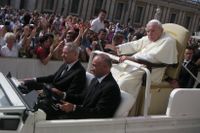
When he became pope in 1978, John Paul II was already an avid sportsman, and he traveled extensively during his papacy. At the time, the 58-year old was extremely healthy and active, jogging in the Vatican gardens, weightlifting, swimming and hiking in the mountains. He was also fond of football and played for Poland in his youth.
John Paul's obvious physical fitness and athletic good-looks earned much comment in the media following his election, which compared his health and trim figure to the poor health of John Paul I and Paul VI, the portliness of John XXIII and the constant claims of ailments of Pius XII. The only modern pope with a keep-fit regime had been Pope Pius XI (1922–1939) who was an avid mountain climber. An Irish Independent article in the 1980s labeled John Paul the "the keep-fit pope."
In 1981, John Paul II's health suffered a major blow after the first failed assassination attempt. He went on to a full recovery, and sported an impressive physical condition throughout the 1980s. Starting about 1992, however, his health slowly declined. He rarely walked in public and began to suffer from an increasingly slurred speech and difficulty in hearing. Most experts agreed that the frail pontiff suffered from Parkinson's disease, although it wasn't until 2003 that the Vatican finally confirmed it. From being strikingly fitter than his predecessors, he had declined physically to far more ill health than was the norm among more elderly popes.
In February 2005 John Paul II was taken to the Gemelli hospital with inflammation and spasm of the larynx, the result of influenza. He was released from the hospital, then taken back after a few days because of difficulty breathing. A tracheotomy was performed, which improved the Pope's breathing but limited his speaking abilities, to his visible frustration. In March 2005, speculation was high that the Pope was near death; this was confirmed by the Vatican a few days before John Paul II died.
Death
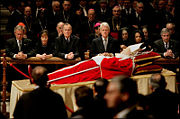
On 31 March 2005 the Pope developed septic shock, a widespread form of infection with a very high fever and profoundly low blood pressure, but was not rushed to the hospital. Instead, he was offered medical monitoring by a team of consultants at his private residence. This was taken as an indication that the pope and those close to him believed that he was nearing death; it would have been in accordance with his wishes to die in the Vatican. Later that day Vatican sources announced that John Paul II had been given the Anointing of the Sick by his friend and secretary Stanisław Dziwisz. During the final days of the Pope's life, the lights were kept burning through the night where he lay in the Papal apartment on the top floor of the Apostolic Palace.
Tens of thousands of people rushed to the Vatican, filling St. Peter's Square and beyond with a vast multitude, and held vigil for two days. Upon hearing of this, the dying pope was said to have stated: "I have searched for you, and now you have come to me, and I thank you."
On Saturday 2 April, at about 15:30 CEST, John Paul II spoke his final words, "Let me go to the house of the Father," to his aides in his native Polish and fell into a coma about four hours later. He died in his private apartment, at 21:37 CEST (19:37 UTC), 46 days short of his 85th birthday. The mass of the vigil of the Second Sunday of Easter, that is, Divine Mercy Sunday which was put into the Church's calendar by him on the occasion of the canonization of St. Faustina on 30 April 2000, had just been celebrated at his bedside. Several aides were present, along with several Polish nuns of the Congregation of the Sisters Servants of the Most Sacred Heart of Jesus, who ran the papal household.
A crowd of over two million present in Vatican City mourned the death of John Paul II. The public viewing of his body in St. Peter's Basilica drew over four million people to Vatican City and was one of the largest pilgrimages in the history of Christianity. Many world leaders expressed their condolences and ordered flags in their countries lowered to half-staff. Numerous countries with a Catholic majority, and even some with only a small Catholic population, declared mourning for John Paul II.
On his death certificate, the primary cause of death was listed as (refractory) septic shock leading to profound hypotension and complete circulatory collapse.
Funeral
The death of the pontiff set in motion rituals and traditions dating back to medieval times. The Rite of Visitation took place from 4 April to 7 April at St. Peter's Basilica. The Mass of Requiem on 8 April was said to have set world records both for attendance and number of heads of state present at a funeral. The Dean of the College of Cardinals, Joseph Ratzinger, who would become the next pope, conducted the ceremony. John Paul II was interred in the grottoes under the basilica, the Tomb of the Popes. He was lowered into a tomb created in the same alcove previously occupied by the remains of Blessed Pope John XXIII. The alcove had been empty since Pope John's remains had been moved into the main body of the basilica after his beatification.
Titles
His title was: Bishop of Rome, Vicar of Jesus Christ, Successor of Saint Peter, Head of the College of Bishops, Supreme Pontiff of the Universal Church, Patriarch of the West (this title was recently removed from the papal list of titles by the reigning pope, Benedict XVI), Primate of Italy, Archbishop and Metropolitan of the Roman Province, Sovereign of the State of the Vatican City, Servus Servorum Dei, Pope John Paul II.
Posthumous recognition and cause for canonization

Since the death of John Paul II, a number of clergy at the Vatican and laymen throughout the world have been referring to the late pontiff as "John Paul the Great" — only the third pope to be so acclaimed, and the first since the first millennium.
His successor, Pope Benedict XVI, referred to him as "the great Pope John Paul II" in his first address from the loggia of St Peter's Church. Pope Benedict XVI, then Cardinal Ratzinger, stirred excitement by some devotees of the pope when in his published written homily for the Mass of Repose, he referred to Pope John Paul II as "the Great."
Since giving his homily at the funeral of Pope John Paul, Pope Benedict XVI has continued to refer to John Paul II as "the Great." At the 2005 World Youth Day in Germany, Pope Benedict XVI, speaking in Polish, John Paul's native language, said, "As the great Pope John Paul II would say: keep the flame of faith alive in your lives and your people." In May 2006, Pope Benedict XVI visited John Paul's native Poland. During that visit he repeatedly made references to "the great John Paul" and "my great predecessor."
In addition to the Vatican calling him "the great," numerous newspapers have also done so. For example the Italian newspaper Corriere della Sera called him "the Greatest" and the South African Catholic newspaper, The Southern Cross, has called him "John Paul II The Great."
Scholars of Canon Law say that there is no official process for declaring a pope "Great"; the title establishes itself through popular, and continued, usage. The three popes who today commonly are known as "Great" are Leo I, who reigned from 440– 461 and persuaded Attila the Hun to withdraw from Rome; Gregory I, 590– 604, after whom the Gregorian Chant is named; and Pope Nicholas I, 858- 867.
On May 9, 2005, Benedict XVI began the beatification process for his predecessor, John Paul II. Normally five years must pass after a person's death before the beatification process can begin. However, in an audience with Pope Benedict XVI, Camillo Ruini, Vicar General of the Diocese of Rome and the one responsible for promoting the cause for canonization of any person who dies within that diocese, cited "exceptional circumstances" which suggested that the waiting period could be waived.
The "exceptional circumstances" presumably refer to the people's cries of "Santo Subito!" ("Saint now!") during the late pontiff's funeral. Therefore the new Pope waived the five year rule "so that the cause of Beatification and Canonization of the same Servant of God can begin immediately." The decision was announced on May 13, 2005, the Feast of Our Lady of Fatima and the 24th anniversary of the assassination attempt on John Paul II at St. Peter's Square. John Paul II often credited Our Lady of Fatima for preserving him on that day. Cardinal Ruini inaugurated the diocesan phase of the cause for beatification in the Lateran Basilica on 28 June 2005.
In early 2006, it was reported that the Vatican was investigating a possible miracle associated with John Paul II. A French nun, confined to her bed by Parkinson's Disease, is reported to have experienced a "complete and lasting cure after members of her community prayed for the intercession of Pope John Paul II". The nun was later identified as Sister Marie-Simon-Pierre, a member of the Congregation of Little Sisters of Catholic Maternity Wards from Puyricard, near Aix-en-Provence.
On May 28, 2006, Pope Benedict XVI said Mass before an estimated 900,000 people in John Paul II's native Poland. During his homily he encouraged prayers for the early canonization of John Paul II and stated that he hoped canonization would happen "in the near future."
In January 2007, it was announced by Stanislaw Cardinal Dziwisz of Krakow, his former secretary, that the key interviewing phase in Italy and Poland of the beatification process was nearing completion. Cardinal Dziwisz had been giving an interview that featured the introduction of his new book in Polish and Italian, Living With Karol, when he made the announcement. In February 2007, the website of the late pope's sainthood cause has stated that relics of Pope John Paul II — pieces of white papal cassocks he used to wear — were being freely distributed with prayer cards for the cause to interested parties; this distribution and prayerful use of relics is a typical praiseworthy pious practice after a saintly Catholic's death.
On 8 March 2007 it was announced that the Vicariate of Rome announced that the diocesan phase of John Paul's cause for beatification is at an end. Following a ceremony on 2 April 2007 — the second anniversary of the Pontiff's death — the cause proceeded to the scrutiny of the committee of lay, clerical, and episcopal members of the Vatican's Congregation for the Causes of Saints, who will conduct an investigation of their own.
Not all Catholic theologians agree with the call for beatification. Eleven dissident theologians, including Jesuit professor Jose Maria Castillo and Italian theologian Giovanni Franzoni raised seven points, including his stance against contraception and the ordination of women (despite the fact his position was reaffirmation of what already had been Catholic teaching) as well as the Church scandals that allegedly presented "facts which according to their consciences and convictions should be an obstacle to beatification."
Life's work
Teachings
As pope, one of John Paul II's most important roles was to teach people about Christianity. He wrote 14 papal encyclicals ( List of Encyclicals of Pope John Paul II) that many observers believe will have long-lasting influence on the church.
In his Apostolic Letter At the beginning of the third millennium ( Novo Millennio Ineunte), he emphasized the importance of "starting afresh from Christ": "No, we shall not be saved by a formula but by a Person." In what he calls a "program for all times," he placed "sanctity" as the single most important priority of all pastoral activities in the entire Catholic Church. He canonized many saints around the world as exemplars for his vision and he supported the prelature of Opus Dei, whose aim is to spread the message of the universal call to holiness and the sanctification of secular activities, which he said is a "great ideal" and a "characteristic mark" of the Second Vatican Council.
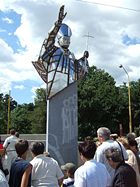
In The Splendour of the Truth ( Veritatis Splendor) he emphasized the dependence of man on God and his law ("Without the Creator, the creature disappears") and the "dependence of freedom on the truth". He warned that man "giving himself over to relativism and skepticism, goes off in search of an illusory freedom apart from truth itself".
In Fides et Ratio (On the Relationship between Faith and Reason) John Paul promotes a renewed interest in philosophy and an autonomous pursuit for Truth in theological matters. Drawing on many different sources (such as Thomism), he describes the mutually supporting relationship between faith and reason, and emphasizes why it is important that theologians should focus on the relationship. John Paul proposes that philosophy has lost its meaning (e.g., the pursuit for objective truth), and that restoring it will ultimately help cure the nihilistic condition of our current age; and, moreover, lead to the Truth of sacred scripture.
John Paul II also wrote extensively about workers and the social doctrine of the Church, which he discussed in three encyclicals. Through his encyclicals, John Paul also talked about the dignity of women and the importance of the family for the future of mankind, and many Apostolic Letters and Exhortations.
Other encyclicals include The Gospel of Life ( Evangelium Vitae) and Orientale Lumen (Light of the East). Often accused of inflexibility through misunderstanding of the office of the papacy in asserting Church Teaching, he explicitly reiterated and asserted unchanged 2,000-year old Catholic teaching on moral matters like murder, euthanasia and abortion. These, like all statements on faith and morals, according to the Congregation for the Doctrine of the Faith, when asserted in the official papal capacity possess the quality referred to as infallibility.
John Paul II, who was present and very influential at the Vatican II (1962–65), affirmed the teachings of that Council and did much to implement them. Nevertheless, his critics often wished aloud that he would embrace the so-called "progressive" agenda that some hoped would evolve as a result of the Council. In fact, the Council did not advocate "progressive" changes in these areas, e.g., still condemning the taking of unborn human life through abortion as an "unspeakable crime". John Paul II continued to declare that contraception, abortion, and homosexual acts were gravely sinful, and, with Cardinal Ratzinger (future Pope Benedict XVI), opposed Liberation theology.
He believed in the Church's exaltation of the marital act of sexual intercourse between a baptized man and woman within sacramental marriage as proper and exclusive to the sacrament of marriage that was, in every instance, profaned by contraception, abortion, divorce followed by a 'second' marriage, and by homosexual acts. Often mistakenly assumed to be a rejection against women, he definitively explained and asserted in 1994 for all time the Church's lack of authority to ordain women to the priesthood, without such authority such ordination is not legitimately compatible with fidelity to Christ. This was also deemed a repudiation of calls to break with the constant tradition of the Church by ordaining women to the priesthood. ( Apostolic Letter 'Ordinatio Sacerdotalis') In addition, John Paul II chose not to end the discipline of mandatory priestly celibacy, although in a small number of unusual circumstances, he did allow certain married clergymen of other Christian traditions who later became Catholic to be ordained as Catholic priests.
John Paul II, as a writer of philosophical and theological thought, was characterized by his explorations in phenomenology and personalism. He is also known for his development of the Theology of the Body.
Philosophers and theologians influenced by him include-among countless others: his successor, Pope Benedict XVI, Jurgen Habermas, John Haas, Andrew Greeley, Rocco Buttiglione, Hans Köchler, George Weigel, Scott Hahn, Mary Beth Bonacci, Deirdre McQuade, Antoinette Bosco, Hans Küng, Yves Congar, Avery Dulles, SJ, John J. Myers, Archbishop Raymond Leo Burke, Joseph Bernardin, Francis Cardinal George, O.M.I., Timothy M. Dolan, Edward Egan, John O'Connor, Bishop Fabian Bruskewitz, Christoph Schonborn, Stanisław Dziwisz, Franciszek Macharski, Józef Glemp, Peter Hans Kolvenbach, S.J., Paolo Dezza, Pedro Arrupe, S.J., Oscar Romero, Mother Teresa, Walter Kasper, Michael Fitzgerald, Jean-Marie Lustiger, André Vingt-Trois, Jarosław Gowin, and Elio Sgreccia.
Pastoral trips

During his pontificate, Pope John Paul II made trips to 117 countries. In total he logged more than 1.1 million km (725,000 miles). He consistently attracted large crowds on his travels, some amongst the largest ever assembled in human history. All these travels were paid by the money of the countries he visited and not by the Vatican.
One of John Paul II's earliest official visits was to Poland, in June 1979, where he was constantly surrounded by ecstatic crowds. The first trip to Poland was sparked the formation of the Solidarity movement in 1980 which brought freedom and human rights to his troubled country. On later trips to Poland, he gave tacit support to the organization. Successive trips reinforced this message and Poland began the process that would finally defeat the domination of the Soviet Union in Eastern Europe in 1989.
While some of his trips (such as to the United States and the Holy Land) were to places previously visited by Pope Paul VI (the first pope to travel widely), many others were to places that no pope had ever visited before, including Mexico in January, (1979) for a Bishops Synod, even before going to Poland for the first time, Ireland later that year in September 1979, Japan (in 1982), South Korea and Puerto Rico (both in 1984). He was the first reigning pope to travel to the United Kingdom, where he met Queen Elizabeth II, the Supreme Governor of the Church of England. In the first visit by a pontiff to Cuba (1998), he sharply criticized Cuba's stance on religious expression, as well as US sanctions against Cuba. In 2000, the first modern Catholic pope to visit Egypt met with the Coptic pope and the Greek Orthodox Patriarch of Alexandria. He was the first Catholic Pope to visit and pray in an Islamic mosque, in Damascus, Syria in 2001. He visited Umayyad Mosque, where John the Baptist is believed to be interred.
In 1988 he made a trip to Lesotho to beatify Joseph Gerrad. On 15 January 1995, during the X World Youth Day, he offered Mass to an estimated crowd of between four and eight million in Luneta Park, Manila, Philippines, considered the largest single event in Christian history. In September 2001 amid post-September 11 concerns, he traveled to Kazakhstan, with an audience of largely Muslims, and to Armenia, to participate in the celebration of the 1700 years of Christianity in that nation. He fluently said Mass in local languages during some visits, including Kiswahili at a Mass in Nairobi, Kenya in 1995 and in an Indonesian language in East Timor.
Throughout his trips, he stressed his devotion to the Blessed Virgin Mary through visits to various shrines to the Virgin Mary, notably Knock in Ireland, Licheń Stary in Poland, Fátima in Portugal, Guadalupe in Mexico and Lourdes in France.
Relations with other religions and denominations
Pope John Paul II traveled extensively and came into contact with believers from many divergent faiths. He constantly attempted to find common ground, both doctrinal and dogmatic. At the World Day of Prayer for Peace, held in Assisi on October 27, 1986, more than 120 representatives of different religions and Christian denominations spent a day together with fasting and praying.
Anglicanism
Pope John Paul II had good relations with the Anglican Church, referred to by Paul VI as "our beloved Sister Church". He preached in Canterbury Cathedral during his visit to Britain, and received Archbishops of Canterbury with friendship and courtesy. However, John Paul II was greatly disappointed by the Anglican Church's decision to offer the sacrament of priestly ordination to women and saw it as a step in the opposite direction from unity between the Anglican Church and Roman Catholicism.
Judaism
Relations between Catholicism and Judaism improved during the pontificate of John Paul II. He spoke frequently about the Church's relationship with Jews.
As a child, Karol Wojtyła had played sports with his many Jewish neighbors. In 1979 he became the first Pope to visit the Nazi Auschwitz concentration camp in Poland, where many of his countrymen (mostly Polish Jews) had perished during the German Nazi occupation. In 1998 he issued "We Remember: A Reflection on the Shoah" which outlined his thinking on the Holocaust. He also became the first pope known to have made an official papal visit to a synagogue, when he visited the Synagogue of Rome on April 13, 1986.
In 1994, in honour of the establishment of diplomatic relations between the Holy See and the State of Israel, Pope John Paul II hosted "The Papal Concert to Commemorate the Holocaust." This concert, which was conceived and conducted by American Maestro Gilbert Levine, was attended by the Chief Rabbi of Rome, the President of Italy, and survivors of the Holocaust from around the world.
In March 2000, John Paul II visited Yad Vashem, (the Israeli national Holocaust memorial) in Israel and later made history by touching the holiest site in Judaism, the Western Wall in Jerusalem, placing a letter inside it (in which he prayed for forgiveness for the actions against Jews in the past). In October 2003 the Anti-Defamation League (ADL) issued a statement congratulating John Paul II on entering the 25th year of his papacy.
Immediately after the pope's death, the ADL issued a statement that Pope John Paul II had revolutionized Catholic-Jewish relations, saying that "more change for the better took place in his 27 year Papacy than in the nearly 2,000 years before." (Pope John Paul II: An Appreciation: A Visionary Remembered).
Eastern Orthodox Church
In May 1999, John Paul II visited Romania on the invitation from Patriarch Teoctist of the Romanian Orthodox Church. This was the first time a pope had visited a predominantly Eastern Orthodox country since the Great Schism in 1054. On his arrival, the Patriarch and the President of Romania, Emil Constantinescu, greeted the Pope. The Patriarch stated, "The second millennium of Christian history began with a painful wounding of the unity of the Church; the end of this millennium has seen a real commitment to restoring Christian unity."
John Paul II visited other heavily Orthodox areas such as Ukraine, despite lack of welcome at times, and he said that an end to the Schism was one of his fondest wishes.
The Pope had also said throughout his pontificate that one of his greatest dreams was to visit Russia, but this never occurred. He had made several attempts to solve the problems which arose over a period of centuries between the Catholic and Russian Orthodox churches, such as giving back the icon of Our Lady of Kazan in August 2004. However, the Russian Orthodox Church never expressed much enthusiasm, making statements to the effect of: "The question of the visit of the Pope in Russia is not connected by the journalists with the problems between the Churches, which are now unreal to solve, but with giving back one of many sacred things, which were illegally stolen from Russia." ( Vsevolod Chaplin).
Buddhism
Tenzin Gyatso, the 14th Dalai Lama and the spiritual leader of Tibetan Buddhism, visited Pope John Paul II eight times, more than any other single dignitary. The Pope and the Dalai Lama often shared similar views and understood similar plights, both coming from peoples affected by communism and both being heads of religious bodies.
Islam
On 6 May 2001, Pope John Paul II became the first Catholic pope to enter and pray in an Islamic mosque. He visited Umayyad Mosque in Damascus, Syria, where John the Baptist is believed to be interred, and gave a speech including the statement: "For all the times that Muslims and Christians have offended one another, we need to seek forgiveness from the Almighty and to offer each other forgiveness." He kissed the Quran in Syria , an act which made him popular amongst Muslims and more unpopular amongst traditional Catholics.
In 2005, Pope John Paul II hosted the "Papal Concert of Reconciliation," which brought together leaders of Islam with leaders of the Jewish community and of the Catholic Church at the Vatican for a concert by choirs from Poland, the United Kingdom, the United States, and Turkey with the Pittsburgh Symphony Orchestra. The event was conceived and conducted by Sir Gilbert Levine, KCSG and was broadcast throughout the world.
The Pope for youth
John Paul II had a special relationship with Catholic youth and is known by some as "The Pope for Youth". Before he was pope he used to camp and mountain hike with the youth. He still went mountain hiking when he was pope. At gatherings, young Catholics and non-Catholics alike were fond of chanting the phrase "JP Two, We Love You", to which John Paul often replied "JP too, He Loves YOU!" He was particularly concerned with the education of future priests, and made many early visits to Roman seminaries, including to the Venerable English College in 1979.
He established World Youth Day in 1984 with the intention of bringing young Catholics from all parts of the world together to celebrate the faith. These week-long meetings of youth occur every two or three years, attracting hundreds of thousands of young people, who go there to sing, party, have a good time and deepen their faith. Some of his most faithful youths gathered themselves in two organizations: " papaboys" and "papagirls."
Apologies
Over the later parts of his reign, John Paul II made several apologies to various peoples who had been wronged by the Catholic Church through the years. Even before he became the Pope, he was a prominent editor and supporter of initiatives like the Letter of Reconciliation of the Polish Bishops to the German Bishops from 1965. During his reign as a Pope, he publicly made apologies for over 100 of these wrongdoings, including:
- The conquest of Mesoamerica by Spain in the name of the Church
- The legal process on the Italian scientist and philosopher Galileo Galilei, himself a devout Catholic, around 1633 ( 31 October 1992).
- Catholics' involvement with the African slave trade ( 9 August 1993).
- The Church Hierarchy's role in burnings at the stake and the religious wars that followed the Protestant Reformation (May 1995, in the Czech Republic).
- The injustices committed against women, the violation of women's rights and for the historical denigration of women ( 10 July 1995, in a letter to "every woman").
- The inactivity and silence of many Catholics during the Holocaust (see the article Religion in Nazi Germany) ( 16 March 1998)
- For the execution of Jan Hus in 1415 ( 18 December 1999 in Prague). When John Paul II visited Prague in 1990s, he requested experts in this matter "to define with greater clarity the position held by Jan Hus among the Church's reformers, and acknowledged that "independently of the theological convictions he defended, Hus cannot be denied integrity in his personal life and commitment to the nation's moral education." It was another step in building a bridge between Catholics and Protestants.
- For the sins of Catholics throughout the ages for violating "the rights of ethnic groups and peoples, and [for showing] contempt for their cultures and religious traditions". ( 12 March 2000, during a public Mass of Pardons).
- For the sins of the Crusader attack on Constantinople in 1204. ( 4 May 2001, to the Patriarch of Constantinople).
Social and political stances
John Paul II was considered a conservative on doctrine and issues relating to reproduction and the ordination of women. No pope, however, has strayed from the Catholic Church's unbroken moral teachings on artificial contraception and the ordination of women.
A series of 129 lectures given by John Paul during his Wednesday audiences in Rome between September 1979 and November 1984 were later compiled and published as a single work entitled " Theology of the Body," an extended meditation on the nature of human sexuality. He also extended it to condemnation of abortion, euthanasia and virtually all uses of capital punishment, calling them all a part of the " culture of death" that is pervasive in the modern world. He campaigned for world debt forgiveness and social justice.
Relations with dictatorships
In 1984 and 1986, through the voice of Cardinal Ratzinger, leader of the Congregation for the Doctrine of the Faith, John Paul II officially condemned the Liberation theology which had many followers in South America. Oscar Romero's attempt, during his visit to Europe, to obtain a Vatican condemnation of El Salvador's regime, denounced for violations of human rights and its support of death squads, was a failure. In his travel to Managua, Nicaragua in 1983, John Paul II harshly condemned what he dubbed the "popular Church" (i.e. " ecclesial base communities" (CEBs) supported by the CELAM), and the Nicaraguan clergy's tendencies to support the leftist Sandinistas, reminding the clergy of their duties of obedience to the Holy See.
John Paul II was criticized for visiting Augusto Pinochet in Chile. He invited him to restore democracy, but, critics claim, not in as firm terms as the ones he used against communist countries. John Paul also allegedly endorsed Pío Cardinal Laghi, who critics say supported the " Dirty War" in Argentina and was on friendly terms with the Argentinean generals of the military dictatorship, allegedly playing regular tennis matches with general Jorge Rafael Videla. However, the Pope has been linked to the fall of Jean-Claude Duvalier's dictatorship in Haiti. He was also critical of the Chinese government and the Chinese Patriotic Catholic Association running the church and appointing bishops without the consent of the Holy See, and maintained strong ties with underground Catholic groups.
The pope, who began his papacy when the Soviets controlled his native country of Poland, as well as the rest of Eastern Europe, was a harsh critic of communism, and supported the Polish Solidarity movement. Soviet leader Mikhail Gorbachev once said the collapse of the Iron Curtain would have been impossible without John Paul II.
In later years, after having harshly condemned Liberation theology, John Paul II criticized some of the more extreme versions of capitalism. "Unfortunately, not everything the West proposes as a theoretical vision or as a concrete lifestyle reflects Gospel values." He saw in capitalism certain "viruses": secularism, indifferentism, hedonistic consumerism, practical materialism, and also formal atheism.
Jubilee 2000 campaign
In 2000 he publicly endorsed the Jubilee 2000 campaign on African debt relief fronted by Irish rock stars Bob Geldof and Bono. It was reported that during this period, U2's recording sessions were repeatedly interrupted by phone calls from the Pope, wanting to discuss the campaign with Bono.
Iraq war
In 2003 John Paul II also became a prominent critic of the 2003 US-led invasion of Iraq. In his 2003 State of the World address the Pope declared his opposition to the invasion by stating, "No to war! War is not always inevitable. It is always a defeat for humanity." He sent former Apostolic Pro-Nuncio to the United States Pío Cardinal Laghi to talk with American President George W. Bush to express opposition to the war. John Paul II said that it was up to the United Nations to solve the international conflict through diplomacy and that a unilateral aggression is a crime against peace and a violation of international law.
European Constitutional Treaty
In European Union negotiations for a new European Constitutional Treaty in 2003 and 2004, the Vatican's representatives failed to secure any mention of Europe's "Christian heritage"—one of the Pope's cherished goals.
Sexuality
While taking a traditional position on sexuality, defending the Church's moral opposition to marriage for same-sex couples, the pope asserted that persons with homosexual inclinations possess the same inherent dignity as everybody else. In his last book, Memory and Identity, he referred to the "pressures" on the European Parliament to permit "homosexual 'marriage'". In the book, as quoted by Reuters, he wrote: "It is legitimate and necessary to ask oneself if this is not perhaps part of a new ideology of evil, perhaps more insidious and hidden, which attempts to pit human rights against the family and against man."
The Pope also reaffirmed the Church's existing teaching on gender in relation to transsexuals, as the Congregation for the Doctrine of the Faith, which he supervised, made clear that transsexuals could not serve in church positions.
Theory of evolution and the interpretation of Genesis
In an 22 October 1996 address to the Pontifical Academy of Sciences, Pope John Paul II reaffirmed the Church's openness to the theory of evolution:
- "In his encyclical Humani Generis (1950), my predecessor Pius XII has already affirmed that there is no conflict between evolution and the doctrine of the faith regarding man and his vocation, provided that we do not lose sight of certain fixed points....Today, more than a half-century after the appearance of that encyclical, some new findings lead us toward the recognition of evolution as more than an hypothesis. In fact it is remarkable that this theory has had progressively greater influence on the spirit of researchers, following a series of discoveries in different scholarly disciplines. The convergence in the results of these independent studies -- which was neither planned nor sought -- constitutes in itself a significant argument in favour of the theory." (John Paul II, Message to the Pontifical Academy of Sciences on Evolution)
In the same address, the Pope rejected any theory of evolution that provides a materialistic explanation for the human soul:
- "Theories of evolution which, because of the philosophies which inspire them, regard the spirit either as emerging from the forces of living matter, or as a simple epiphenomenon of that matter, are incompatible with the truth about man."
John Paul II also wrote to the Pontifical Academy of Sciences on the subject of cosmology and how to interpret Genesis:
- " Cosmogony and cosmology have always aroused great interest among peoples and religions. The Bible itself speaks to us of the origin of the universe and its make-up, not in order to provide us with a scientific treatise, but in order to state the correct relationships of man with God and with the universe. Sacred Scripture wishes simply to declare that the world was created by God, and in order to teach this truth it expresses itself in the terms of the cosmology in use at the time of the writer. The Sacred Book likewise wishes to tell men that the world was not created as the seat of the gods, as was taught by other cosmogonies and cosmologies, but was rather created for the service of man and the glory of God. Any other teaching about the origin and make-up of the universe is alien to the intentions of the Bible, which does not wish to teach how heaven was made but how one goes to heaven." (Pope John Paul II, October 3, 1981 to the Pontifical Academy of Science, "Cosmology and Fundamental Physics")
Syro-Malankara Catholic Church
On February 10, 2005, Pope John Paul II elevated the Archdiocese of Trivandrum to a Major Archdiocese, elevating the Archbishop to Major Archbishop (called Catholicos by Syro-Malankara Catholics). As a major archiepiscopal church, the Syro-Malankaras are granted the greatest level of self-government (autonomy) under the Code of Canons of the Eastern Churches, governed by the major archbishop and the general synod of all bishops of the church, subject to papal oversight.
Criticisms
John Paul II was criticized for his support of the Opus Dei prelature and the canonization of its founder, Jose María Escrivá. Escrivá's detractors call him an admirer of Spanish dictator Francisco Franco. Other movements and religious organizations of the Church went decidedly under his wing ( Legion of Christ, the Neocatechumenal Way, Schoenstatt, the Charismatic Movement etc.) and he was accused repeatedly of waving a soft hand on them, especially in the case of Rev. Marcial Maciel, founder of the Legion of Christ.
John Paul II's defense of traditional moral teachings of the Catholic Church regarding gender roles, sexuality, euthanasia and artificial contraception came under attack. Some feminists criticized his traditional positions on the roles of women, which included rejecting women priests. Many gay-rights activists and others criticized him for maintaining the Church's unbroken opposition to homosexuality and same-sex marriage. Critics have also claimed that large families are caused by lack of contraception and exacerbate Third World poverty and problems such as street children in South America. In 2007, TIME magazine reported that the manner of John Paul II's death may have contravened his own position on using medical means to prolong life.
In addition to all the criticism from those demanding modernization, traditional Catholics sometimes denounced him from the right, demanding a return to the Tridentine Mass and repudiation of the reforms instituted after the Second Vatican Council, such as the use of the vernacular language in the formerly Latin Rite Mass, ecumenism, and the principle of religious liberty. He was also accused by these critics for allowing and appointing liberal bishops in their sees and thus silently promoting Modernism, which was firmly condemned as the "synthesis of all heresies" by his predecessor Pope St. Pius X. In 1988, the controversial traditionalist Archbishop Marcel Lefebvre, founder of the Society of St. Pius X (1970), was excommunicated under John Paul II because of the unapproved ordination of four bishops, which was called by the Holy See a "schismatic act". The International Peace Prayer Conference John Paul II held in Assisi, Italy, in 1986 was heavily criticized as giving the impression that syncretism and/or indifferentism were openly embraced by the papal magisterium. When the second instance the Conference was held, in 2002, it was condemned as confusing the laity and compromising to "false religions". Likewise criticized were his kissing of the Quran in Damascus, Syria, on one of his travels on 6 May 2001 - ( a thorough analysis). His call for religious freedom was not always supported; bishops like Antônio de Castro Mayer promoted religious tolerance, but at the same time rejected the Vatican II principle of religious liberty as being liberalist and already condemned by Pope Pius IX in his Syllabus errorum (1864) and at the First Vatican Council.
John Paul II took an absolutist position against artificial birth control, including the use of condoms to prevent the spread of HIV. This position was harshly criticized by doctors and AIDS activists, who said that it led to countless deaths and millions of AIDS orphans. It also led to an unusually public debate among senior figures in the Church. The Catholic Agency for Overseas Development published a paper stating, "Any strategy that enables a person to move from a higher-risk towards the lower end of the continuum, [we] believe, is a valid risk reduction strategy."
John Paul II was also criticized for failing to respond quickly enough to the sex abuse crisis, and for recentralizing power back to the Vatican following what some viewed as a decentralization by Pope John XXIII. As such he was regarded by some as a strict authoritarian. Conversely, he was also criticized for spending far too much time preparing for and undertaking foreign travel. The frequency of his trips, it was said, not only undermined the "specialness" of papal visits, but took him away from important business at the Vatican and allowed the Church, administratively speaking, to drift.
There was strong criticism of the pope for the controversy surrounding the alleged use of charitable social programs as a means of converting people in the Third World to Catholicism. The Pope created an uproar in the Indian subcontinent when he suggested that a great harvest of faith would be witnessed on the subcontinent in the third Christian millennium.
Honours and namesakes
The pontiff was celebrated during his lifetime and later posthumously with several honours and as the namesake of several places and institutions. Such places often bear the name John Paul II but newer institutions are using the name John Paul the Great.
Educational and cultural centers named in honour of the Pope include the Pontifical John Paul II Institute for Studies on Marriage and Family whose largest campuses are located at the Lateran University in Rome, Italy and Catholic University of America in Washington, DC, United States. Affiliated campuses are found in Australia, Benin, Brazil, India, Mexico and Spain. There is also a Pope John Paul II Cultural Centre in the United States capital. John Paul the Great Catholic University is a rededicated degree-granting institution in San Diego, California. Several John Paul II Catholic Centers may be found on college and university campuses around the world, usually serving students and staff as Roman Catholic chapels. Several elementary and secondary schools also use the name John Paul II or John Paul the Great, like John Paul the Great Catholic High School in Prince William County, Virginia, administered by the Dominican Sisters of Saint Cecilia or "Nashville Dominicans." (The cornerstone and tabernacle of the school were blessed by Pope Benedict XVI during Mass at Nationals Park in Washington, D.C. on April 17, 2008.)
Several national and municipal public projects were named in honour of the Pope. Rome's main railway station, the Roma Termini station, was dedicated to Pope John Paul II by a vote of the City Council, a first municipal public object in Rome bearing the name of a non Italian. International airports named after him are John Paul II International Airport Kraków-Balice — one of the principal airports of Poland — and the João Paulo II Airport in the Azores. The Juan Pablo II Bridge is located in Chile, while John Paul II Square in Bulgaria denotes the Pope's visit to Sofia in 2002. Parvis Notre-Dame - Place Jean-Paul II is a centerpiece of one of Paris' neighborhoods. Pope John Paul II Park is a feature of Boston, Massachusetts while Pope John Paul II Drive serves residents of Chicago, Illinois.
Of international interest, Ioannes Paulus II Peninsula on Livingston Island in the South Shetland Islands was named in honour of the Pope. The Antarctic landmark recognizes his contribution to world peace and understanding among people.
The Pope was named Time Magazine's Person of the year in 1994. In 2000, he was also made an honorary Harlem Globetrotter. In February 2004 Pope John Paul II was nominated for a Nobel Peace Prize honoring his life's work in opposing Communist oppression and helping to reshape the world.
